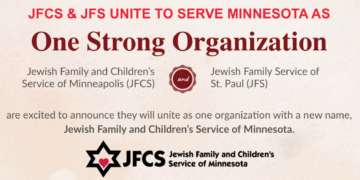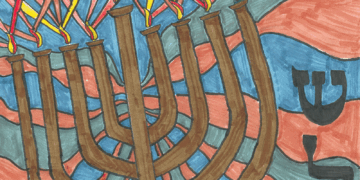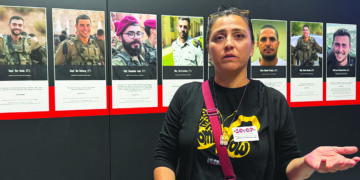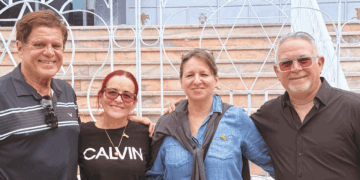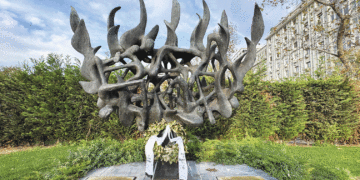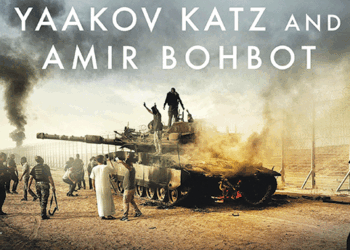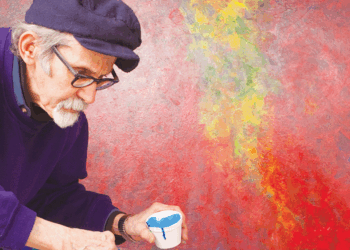Reviewed by NEAL GENDLER
It’s hard to tell how angry Paul Mayer was at the Nazis who ended his law career before it started, but his son Steven clearly is furious.
So furious that he uses the “f” word as an adjective when mentioning Nazis while describing his father’s life and work in My Father Against the Nazis.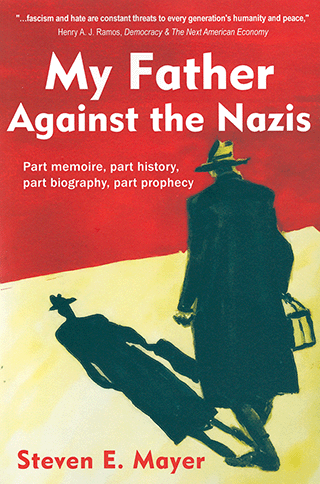
Near book’s end, he says: “I never actually heard my father speak against the Nazis. … Of course there was much he never said,” at least not to his son. “Maybe he couldn’t bring himself to utter their name.”
It’s unfortunate Paul didn’t tell Steven more about his life in Germany, his feelings at being denied his career, fleeing Germany and interrogating German prisoners of war.
What we learn comes through Steven, a consulting psychologist who has lived in Minneapolis and founded Rainbow Research — a nonprofit to help socially concerned organizations — named during breakfast at the now-vanished Rainbow Café on the corner of Hennepin and Lake.
My Father unfolds in a form the author says he borrowed from author John Dos Passos: starting chapters with a “newsreel”: bold face, dated headlines listing events of that period. This technique fits the cover’s description as “part memoir, part history, part biography and part prophecy.”
While interesting, My Father, which includes photos, is more like a conversation than typical nonfiction, the narrative sometimes interrupted to speak directly to the reader. Interspersed are boldfaced lines such as: “Raus! We’ll make it impossible for you filthy Jews to stay!”
Notable errors should have been fixed by an editor.
The United States entered World War 1 in 1917, not 1918.
Mention of big Soviet cities conquered by Germany wrongly includes Leningrad; 28 pages later, a newsreel correctly says Leningrad was liberated from a 900-day siege.
Most of a newsreel on page 89 is repeated on page 91.
Perhaps incorrectly: When war began, Britain’s Prime Minister Chamberlain “had to acknowledge” that “he’d failed to find ‘peace in our time,’ something he’d promised just days earlier.” Chamberlain might have said that days before Sept. 1, 1939, but the famous quote — actually “peace for our time” — originated Sept. 30, 1938, on his return from the Munich conference.
Inability to distinguish between a hyphen, which connects words, and a dash, which separates them, is an amateurish and confusing error.
Those don’t sully the story of Paul Mayer, born in 1907 in Köln, Germany, to prominent orthopedist Ernst Mayer. The family lives well, and Paul enters the University of Köln in 1926, also studying in Berlin, Geneva and Paris and graduating with a doctorate in law and economics in 1931. In 1933, he’s admitted to the bar of the High Court of Köln on March 23.
He never unwraps his robe: In April, Jews are excluded from civil service.
Emigrating isn’t appealing. “He was a German who loved his country,” Steven says. “Turns out he wasn’t German enough.”
In 1933, he visits Paris. Seeking advice from the Agency for Human Rights, he offers to help an attractive, discouraged woman ahead of him. She is Margarete (Margo) Koch, heiress to Germany’s prestigious Koch jewelry. She’s 22, he’s 27. Marriage follows.
They consider moving to the United States, visiting in 1937. But they return to Germany.
Paul works at a Jewish-owned industrial company that also has an office in Amsterdam. In 1938, the couple visits to consider moving there if German life worsens.
Kristallnacht, Nov. 9-10, 1938, finally convinces them to leave. Transit visas to Britain bypass the year-long U.S. visa line in Germany. They reach Hoboken, N.J., in 1940, met by Margo’s cousins. Later, Margo’s widowed mother arrives, the Kochs having been stripped of their business.
With the United States at war, Paul enlists. He’s 35. “While Paul quickly took to Army life, the Army took a long time to figure out what to do with him, an older inductee” and enemy alien, Steven says. Paul is sent to a military police training post. He becomes a U.S. citizen in February 1943.
In July, Paul is sent to the University of Illinois to write a dissertation on a postwar anti-crime infrastructure for Germany. He takes political science courses, writes a dissertation and is awarded a Ph.D. He’s jumped two stripes to staff sergeant.
The Army has realized its access to young, educated native speakers of German who understand how Germans think and act. In December, Paul is sent to then-secret Camp Ritchie, Maryland, where refugees like him train for intelligence work including interrogating captured Germans.
In France, one of the Germans he interrogates is a former close friend, Anton Comes, who later uses his own legal training and connections to help Paul’s restitution efforts.
In late December 1944, Paul collapses from a ruptured duodenal ulcer. He’s hospitalized for weeks, then sent home on a hospital ship for two months in a hospital at Utica, N.Y.
Discharged in April 1945, he starts work at a Manhattan trading company. He later has a government career.
The author describes his father as spending hours and hours at his typewriter, seeking restitution for the property taken from his parents before they were sent to Theresienstadt and murdered at Auschwitz. He seeks restitution for others and becomes “acknowledged as one of the nation’s leading restitution lawyers,” Steven says.
Physical recovery is incomplete; another operation is required in 1950. Mental recovery, despite steady professional work and friends, never is complete.
“My father spent the rest of his life in mourning,” Steven says. “He never found any real peace in his new country. … He lived an uprooted and alienated life until he died, an event surely hastened by a visit he made to Auschwitz in 1979, where he suffered a breakdown of sorts from which he never recovered.”
***
Neal Gendler is a Minneapolis writer and editor.
(American Jewish World, November 2025)

